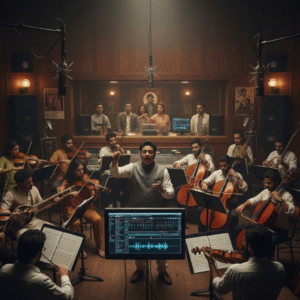Who Holds the Power in India Today?
Mumbai – 2025
The Indian music industry, once tightly held by legacy labels and film studios, is undergoing a visible transformation. A new breed ofindependent artists, untethered from traditional contracts and studio hierarchies, is rising steadily—streaming directly into the ears of millions.
As this shift accelerates, a critical question surfaces:In India’s digital-first era, do record labels still control the music business—or is creative power moving into the hands of independent musicians?
Labels: Once Gatekeepers, Now One of Many
Historically, major labels likeT-Series,Sony Music India, andZee Musicdominated:
- Radio play
- Film music releases
- Physical distribution (CDs, cassettes)
- Artist branding and live performances
They still hold significant influence—particularly inBollywood soundtracks, where licensing, promotional muscle, and studio partnerships remain critical.
But the arrival ofYouTube,Spotify, andInstagram Reelshas disrupted this model.
The Rise of the Self-Made Star
Artists like:
- King (Tu Aake Dekhle)
- Prateek Kuhad (cold/mess)
- Anuv Jain, Akanksha Sethi, and OAFF
- Hanita Bhambri, Seedhe Maut, and Yohani
…have built massive audiences without being “launched” by a label.
Instead, they:
- Self-publish via DistroKid, TuneCore, or Believe
- Promote through reels, Reddit, or curated playlists
- Engage fans directly via live sets, Q&As, or crowdfunding
Theirownership over content and imageis non-negotiable—something that traditional label contracts rarely offered.
The Streaming Power Shift
As per theIMI Digital Music Report 2024, nearly37% of top-streamed Hindi trackscame from independent creators or non-film sources.
Moreover:
- Indie tracks dominate Spotify India’s editorial playlists
- YouTube first releases are outperforming many label-produced tracks
- Artists control their release timelines, branding, and collaborations
In essence,distribution no longer requires permission. Just vision.
What Labels Still Offer
Despite the disruption, record labels aren’t obsolete.
They still provide:
- Massive promotional budgets
- Cross-media exposure (TV, film, radio)
- Music video production support
- Access to elite Bollywood collaborations
- International sync licensing
For artists looking to scale globally or break into film scoring,a label’s infrastructure can accelerate credibility.
Some musicians, likeDIVINEandRitviz, maintain ahybrid model—retaining creative control while partnering with labels for scale.
Challenges for Independent Artists
Being independent is liberating—but also demanding:
- Full responsibility for marketing, distribution, and legal
- Budget constraints
- Difficulty in accessing big playlists or media coverage
- Inconsistent income from streams and gigs
Many indie artists must masternot just music—but branding, analytics, and community building.
The Way Forward: Coexistence with Autonomy
The future of Indian music likely lies ina more equal ecosystem, where:
- Labels adapt to flexible contracts and artist-led projects
- Indie artists use tech and community to bypass gatekeeping
- Revenue models evolve to include merch, sync deals, live sets, and NFTs
Final Chord
Power in India’s music industry is no longer about contracts—it’s aboutconnection.
Those whoown their sound, audience, and valueswill lead the next era.
Whether independent or label-backed, the artist who wins is the one who listens—not just to music, but to themovement around it.













